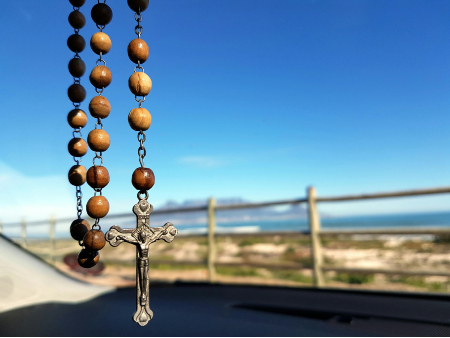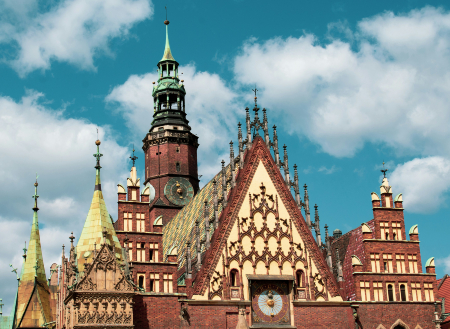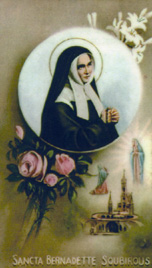We ask you, humbly: don't scroll away.
Hi readers, it seems you use Catholic Online a lot; that's great! It's a little awkward to ask, but we need your help. If you have already donated, we sincerely thank you. We're not salespeople, but we depend on donations averaging $14.76 and fewer than 1% of readers give. If you donate just $5.00, the price of your coffee, Catholic Online School could keep thriving. Thank you.Help Now >
Papal Coat of Arms Still Relevant
FREE Catholic Classes
Interview With Expert on Ecclesiastical Heraldry
DARLINGHURST, Australia, SEPT. 16, 2007 (Zenit) - Ecclesiastical heraldry is as relevant today as it ever was, and should be valued as part of the Church's rich cultural and artistic patrimony, according to an author of a book on papal arms.
Michael McCarthy, founder and proprietor of Australia's Thylacine Press, argued that point in his book "Armoria Pontificalium: A Roll of Papal Arms 1012-2006."
In this interview with us, which McCarthy gave before his sudden death Aug. 3 at age 57, he spoke about the place of ecclesiastical heraldry in the modern Church.
Q: What is ecclesiastical heraldry?
McCarthy: Heraldry, of which coats of arms are the central part, is a system of pictorial identification making it possible to determine a person's identity, rank and standing in society.
In heraldry, rank is always denoted by headgear. For example, kings are denoted by crowns, and bishops first by miters and then, from about 1600, by a series of flat broad-rimmed pontifical hats with cords and numbers of tassels. The various colors and numbers of tassels show the rank of the user from cardinal down to priest.
Additionally, in northern and English-speaking countries most dioceses have also adopted arms, and these are incorporated into the shields of their bishops. Displayed on seals, documents and buildings, these identify what belongs to whom and in whose name acts are carried out. A perusal of the Web sites of dioceses and bishops will bear this out and demonstrates their continued relevance today in the Internet age.
Q: Who was the first pope to have had a coat of arms?
McCarthy: It is not known which pope was the first. Heraldry emerged in the 12th century as a means of identifying people in battle. Because most of the knights were illiterate it also very quickly became a form of general identification, especially on seals, etc. From there it was a short step for ecclesiastics to do the same and this unique system of identification came into its own. Popes have been credited with coats of arms back to St. Peter, but it is generally accepted that Innocent III -- 1198-1215 -- was the first.
Q: Benedict XVI has altered heraldic custom, using the miter instead of the papal tiara and adding the pallium. Why do you think he did this?
McCarthy: All things evolve and heraldry is no exception. Benedict XVI, on becoming Pope, made it plain to the designer of his arms that he did not want a crown because he did not wish to be seen as a king. He added the pallium because he wanted to indicate the importance of communion with the Church. The pallium is used by metropolitans to show communion with the Pope and this seemed a logical step forward.
The papal tiara had a long history of development over a period of about 1,700 years. Originally in appearance it was merely a tall conical hat known as the camelaucum, which might have evolved from a miter sewn together at each side to mark the wearer as different from his fellow bishops.
However, it is more likely that it had its origins in the Phrygian Cap which the Emperor Constantine presented to Sylvester I -- 314-335. It should be remembered that the miter, when it emerged in the 10th century, was originally worn with the points over the ears, suggesting that the papal miter had been opened for the use of bishops but was incomplete to show the lesser status of the wearer.
The first coronet seems to have been used by Nicholas II -- 1059-1061. Given the historical context of that period, the reason for this is not hard to fathom. As well as being the Pontiff, he was a temporal ruler and presumably this was expressed by the coronet; the feudal mind liked to have everything clearly defined.
This single coronet remained in vogue until the end of the 13th century, but with the ascension of Boniface VIII -- 1294-1303 -- a gradual change began. Benedict XII -- 1334-1342 -- is credited with the addition of the third coronet, once again for obscure reasons, although his successor Clement VI -- 1342-1352 -- seems to have been the first Pope to have actually used it. Perhaps the way forward is to restore the camelaucum in its original form to show the unique nature of the papal office, devoid of any allusion to kingship.
Q: What is the story of Benedict XVI's shield?
McCarthy: The elements of the Pope's shield, including the Moor's head and the bear wearing a backpack, both commemorate St. Corbinian, a seventh-century bishop of Freising -- now Munich and Freising. The bishop was supposedly black-skinned and he, on a pilgrimage to Rome, encountered a bear which killed his horse. The saint then compelled the bear to carry his baggage for him instead.
Today the Moor's head is the emblem of the Diocese of Munich Freising, while the bear is the emblem of the town of Freising. Along with the scallop shell -- the symbol of the pilgrim -- the Pope uses these elements to show his origins.
Q: Ecclesiastical heraldry constitutes part of the Catholic Church's rich cultural heritage, but is perhaps not well understood today. Is it still relevant today?
McCarthy: In spite of claims to the contrary, heraldry in general is an expression of the Church's rich cultural heritage, rising as it did as a byproduct of the Crusades as an expression of piety and pilgrimage. Heraldry has been incorporated into the fabric of art and buildings ever since.
Its use in the buildings of Rome, for instance, helps place the context of each building and shows which Pope or cardinal was responsible for it. Similarly, in all the dioceses around the world, the use of heraldry helps to enrich and identify the cultural life of the building.
The Internet is helping to create a new interest in the use of heraldry. Immediately after the Second Vatican Council, the use of arms by ecclesiastics went into a decline and it seemed to be on the way out.
However, there is now a resurgence in heraldry and the fact that the Pope's use of the miter on his shield created a furor in certain quarters shows that a lively interest still exists.
Q: What do you hope your new book will achieve?
McCarthy: This latest book, "Amoria Pontificalium," is the last in a series I began in 2000 which include lists of all cardinals created since 1198 and their arms.
In doing this I have attempted to preserve this rich information for posterity and to demonstrate the richness of our ecclesiastical cultural heritage. The current work, on papal arms, which has been produced in color, is the last chapter is this work and demonstrates clearly what I set out to achieve.
Contact
Catholic Online
https://www.catholic.org
CA, US
Catholic Online - Publisher, 661 869-1000
info@yourcatholicvoice.org
Keywords
Papal, Coat, Arms, Heraldry, McCarthy
We ask you, humbly: don't scroll away.
Hi readers, it seems you use Catholic Online a lot; that's great! It's a little awkward to ask, but we need your help. If you have already donated, we sincerely thank you. We're not salespeople, but we depend on donations averaging $14.76 and fewer than 1% of readers give. If you donate just $5.00, the price of your coffee, Catholic Online School could keep thriving. Thank you.Help Now >
More Catholic PRWire
Showing 1 - 50 of 4,716
A Recession Antidote
Randy Hain
Monaco & The Vatican: Monaco's Grace Kelly Exhibit to Rome--A Review of Monegasque-Holy See Diplomatic History
Dna. Maria St. Catherine Sharpe, t.o.s.m., T.O.SS.T.
The Why of Jesus' Death: A Pauline Perspective
Jerom Paul
A Royal Betrayal: Catholic Monaco Liberalizes Abortion
Dna. Maria St.Catherine De Grace Sharpe, t.o.s.m., T.O.SS.T.
Embrace every moment as sacred time
Mary Regina Morrell
My Dad
JoMarie Grinkiewicz
Letting go is simple wisdom with divine potential
Mary Regina Morrell
Father Lombardi's Address on Catholic Media
Catholic Online
Pope's Words to Pontifical Latin American College
Catholic Online
Prelate: Genetics Needs a Conscience
Catholic Online
State Aid for Catholic Schools: Help or Hindrance?
Catholic Online
Scorsese Planning Movie on Japanese Martyrs
Catholic Online
2 Nuns Kidnapped in Kenya Set Free
Catholic Online
Holy See-Israel Negotiation Moves Forward
Catholic Online
Franchising to Evangelize
Catholic Online
Catholics Decry Anti-Christianity in Israel
Catholic Online
Pope and Gordon Brown Meet About Development Aid
Catholic Online
Pontiff Backs Latin America's Continental Mission
Catholic Online
Cardinal Warns Against Anti-Catholic Education
Catholic Online
Full Circle
Robert Gieb
Three words to a deeper faith
Paul Sposite
Relections for Lent 2009
chris anthony
Wisdom lies beyond the surface of life
Mary Regina Morrell
World Food Program Director on Lent
Catholic Online
Moral Clarity
DAN SHEA
Pope's Lenten Message for 2009
Catholic Online
A Prayer for Monaco: Remembering the Faith Legacy of Prince Rainier III & Princess Grace and Contemplating the Moral Challenges of Prince Albert II
Dna. Maria St. Catherine Sharpe
Keeping a Lid on Permissiveness
Sally Connolly
Glimpse of Me
Sarah Reinhard
The 3 stages of life
Michele Szekely
Sex and the Married Woman
Cheryl Dickow
A Catholic Woman Returns to the Church
Cheryl Dickow
Modernity & Morality
Dan Shea
Just a Minute
Sarah Reinhard
Catholic identity ... triumphant reemergence!
Hugh McNichol
Edging God Out
Paul Sposite
Burying a St. Joseph Statue
Cheryl Dickow
George Bush Speaks on Papal Visit
Catholic Online
Sometimes moving forward means moving the canoe
Mary Regina Morrell
Action Changes Things: Teaching our Kids about Community Service
Lisa Hendey
 Hi readers, it seems you use Catholic Online a lot; that's great! It's a little awkward to ask, but we need your help. If you have already donated, we sincerely thank you. We're not salespeople, but we depend on donations averaging $14.76 and fewer than 1% of readers give. If you donate just $5.00, the price of your coffee, Catholic Online School could keep thriving. Thank you. Help Now >
Hi readers, it seems you use Catholic Online a lot; that's great! It's a little awkward to ask, but we need your help. If you have already donated, we sincerely thank you. We're not salespeople, but we depend on donations averaging $14.76 and fewer than 1% of readers give. If you donate just $5.00, the price of your coffee, Catholic Online School could keep thriving. Thank you. Help Now >
Easter... A Way of Life
Paul Spoisite
Papal initiative...peace and harmony!
Hugh McNichol
Proclaim the mysteries of the Resurrection!
Hugh McNichol
Jerusalem Patriarch's Easter Message
Catholic Online
Good Friday Sermon of Father Cantalamessa
Catholic Online
Papal Address at the End of the Way of the Cross
Catholic Online
Cardinal Zen's Meditations for Via Crucis
Catholic Online
Interview With Vatican Aide on Jewish-Catholic Relations
Catholic Online
Pope Benedict XVI On the Easter Triduum
Catholic Online
Holy Saturday...anticipation!
Hugh McNichol









 Daily Readings for Tuesday, April 16, 2024
Daily Readings for Tuesday, April 16, 2024 St. Bernadette: Saint of the Day for Tuesday, April 16, 2024
St. Bernadette: Saint of the Day for Tuesday, April 16, 2024 Prayer for our Family #1: Prayer of the Day for Tuesday, April 16, 2024
Prayer for our Family #1: Prayer of the Day for Tuesday, April 16, 2024

